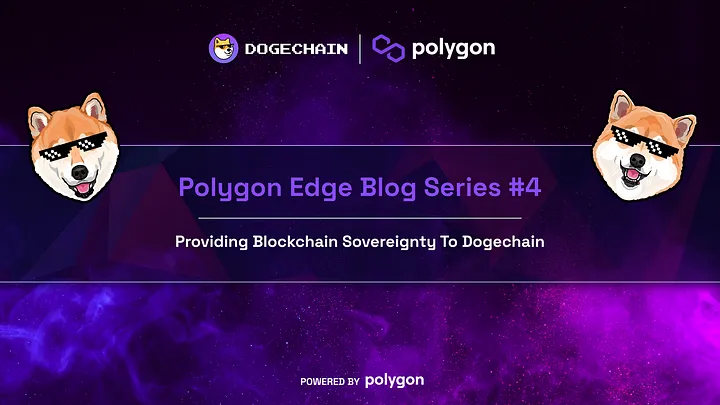This fourth entry of our blog series on the Polygon Edge framework covers the benefits of blockchain sovereignty. More precisely, the article will analyze the growing demand for blockspace, which leads to an inevitable evolution towards an internet of blockchains.
TL;DR
- Sovereign blockchains struggle to create a reliable set of validators.
- Polygon Edge ameliorates this situation
- Polygon Supernets aims to offer sovereign blockchains an instant set of validators.
What Is Polygon Edge?
If you missed our introductory posts about Polygon Edge, let’s quickly give you a rundown of what this framework represents. Polygon Edge is a developer toolset that allows the creation of standalone, EVM-compatible blockchains. Thus, blockchains built with Polygon Edge readily accommodate Ethereum smart contracts and the deployment of dApps.
Polygon Edge also allows developers to tailor blockchains to their specific needs. Indeed, its modular design is predicated on a lego-like approach, enabling developers to configure essential layers of the stack (consensus, distribution, access control) separately.
The result is a fully scalable, high-performance blockchain that facilitates constant and predictable throughput for each use case.
What Is Blockchain Sovereignty?
Developers that fully control a blockchain’s network architecture exercise what is known as blockchain sovereignty. As the term implies, blockchain sovereignty denotes the ability of a blockchain to maintain its independent status, especially with regard to network validators (whether Proof-of-Stake or Proof-of-Authority).
Industry observers frequently compare network validators to bankers, given that they are responsible for verifying incoming transactions. However, they also maintain system efficiency, facilitate governance, ensure network security, and (not least of all) enable new blocks to form in the blockchain,
While many project teams rely on a shared system of validators for their blockchains, a growing number of them seek greater independence and flexibility.. After all, fully sovereign blockchains can implement their own consensus model and are better suited to support unique use cases.
Unfortunately, blockchains that pursue this model must typically sacrifice a more rigorous security setup to do so. Moreover, an intense degree of complexity exists when it comes to “bootstrapping a (fully) decentralized and reliable validator set with well-designed coordination mechanisms.” (Polygon)
Indeed, sovereign blockchains frequently operate with a low number of validators, putting the system at risk of becoming more centralized.
Polygon Edge enables developers to overcome many of these issues. Doing so is crucial if the blockchain world aspires to achieve an “internet of blockchains.” Polygon has made the phrase an integral part of its vision as it endeavors to create a multichain ecosystem of blockchains compatible with Ethereum.
Why Is It Important To Have a Standalone Blockchain?
As blockchain technology become mainstream, blockspace demand has inevitably risen. Its continuing acceptance suggests that a single blockchain will not be able to cater to a global set of users, regardless of scale.
Polygon’s “internet of blockchains’’ provides one option, enabling blockchain users to move seamlessly among EVM-compatible blockchains. At the same time, it’s creating a framework for its interoperability with other layer-2 solutions, sidechains, and sovereign blockchains.
Standalone blockchains on Polygon are especially relevant here, as they rely on the original Matic proof-of-stake sidechain (rather than Matic’s Plasma L2 solution). The distinction suggests that they will be more resilient due to increased user demands.
In the case of Dogechain, however, the team has chosen not to rely on the shared security of Polygon. Instead, Dogechain relies on its separate set of validators, emphasizing its sovereignty and standalone approach.
And even though stand-alone blockchains must rely on their own validators, Polygon enables them to enjoy full interoperability on the Ethereum mainchain without having to opt for Polygon’s security-as-a-service model.
The SuperNet Allure
While Polygon fully supports stand-alone (sovereign) blockchains, its latest technology offering will tempt many to forego that status. Polygon Supernets provide blockchains with a dedicated network built for a specific application or use case. They’re also able to connect to Ethereum and each other.
The Polygon team frequently refers to them as “Polygon Edge on steroids.”
They offer blockchains a “shared security layer in the form of a MATIC-staked validator marketplace.” In practical terms, any project employing a Supernet receives instant access to a decentralized, reliable Proof of Stake validator set.
Thanks to its underlying architecture built on Polygon Edge, the team will be able to plug Dogechain into the growing Supernets network.
Polygon Supernets make it easy to forego the challenges of bootstrapping a validator network. Nonetheless, it’s important to note that sovereign blockchains wishing to use a Supernet can still retain their own set of validators.
Concluding Thoughts
By fulfilling its vision, Polygon has made it much easier for sovereign blockchains to thrive. With Polygon Edge, developers can quickly build sovereign blockchains with a set framework, providing the prerequisites for a true “internet of blockchains” to emerge.
In the near future,, the Dogechain team will be relying on this new technology to enable Dogechain’s ecosystem of dApps (using wrapped $DOGE as currency) to interoperate seamlessly with other blockchains.
And while it may appear that Polygon is using Supernet technology to co-opt sovereign blockchains, in reality, it’s enabling them to survive and scale. In short, expect Supernets to supercharge sovereign blockchain growth.
Both technologies highlight why Dogechain and other blockchains increasingly align themselves with the multichain.
Dogechain is bringing DeFi & long awaited utility to Dogecoin. Join the family!
Website | Twitter | Telegram | Discord | Reddit | TikTok

